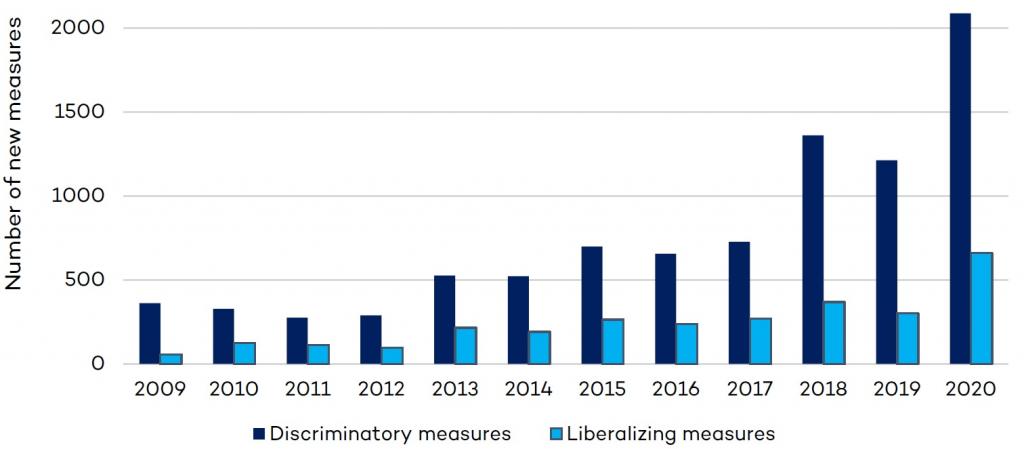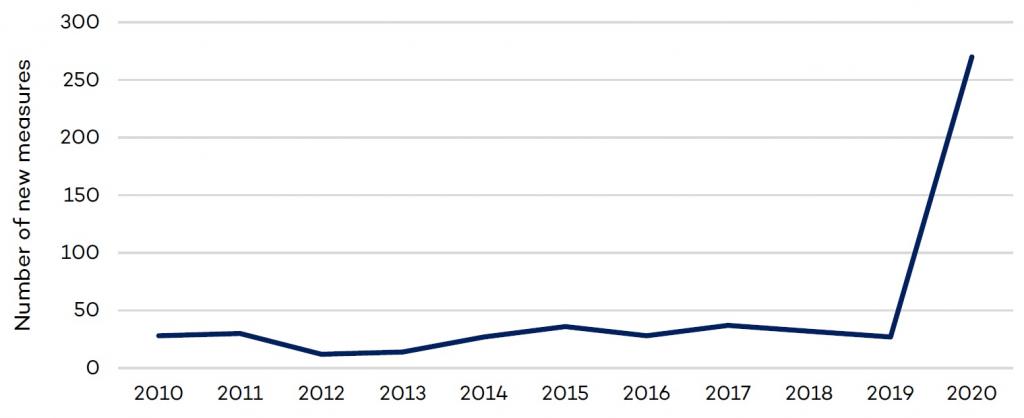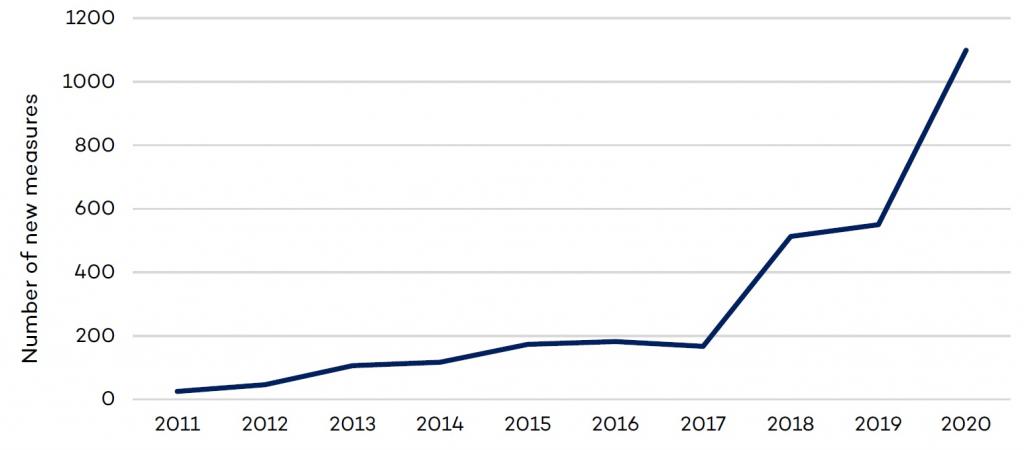Rising Protectionism Signals Valuable Lessons Have Been Forgotten
Per Altenberg from the Swedish National Board of Trade looks back after five years of monitoring protectionism and finds that the trend toward establishing new traditional tariff measures and non-tariff barriers has continued.
This article was originally published in IISD's Trade and Sustainability Review, Volume 1, Issue 3.
Five years ago, the Swedish National Board of Trade (Kommerskollegium) published a report that mapped protectionism worldwide and across different modes of trade: trade in goods, trade in services, foreign direct investment (FDI), data flows, and trade-related movement of people. The idea was not to add another measure of protectionism but to synthesize available evidence to provide a comprehensive picture of the state and direction of modern protectionism. It also sought to separate the monitoring of protectionism from political considerations as much as possible.
In 2016, we observed worrying signs that protectionism was on the rise. Tariffs on goods, which had been on a downward trajectory in the last part of the 20th century, had levelled out in the first part of the 21st century.
We saw as one potential explanation for this trend the fact that countries maintain tariffs to use them as bargaining chips in trade negotiations. And because these (multilateral) talks were never concluded, the paradoxical consequence was that 21st-century trade negotiations might have prevented rather than promoted tariff liberalization.
For many non-tariff barriers, we observed an increase during the period leading up to 2016. Countries progressively resorted to discretionary and non-transparent measures instead of traditional, transparent, and well-regulated trade barriers such as tariffs. Developments with respect to subsidies, domestic content requirements, and restrictions on public procurement were viewed as especially concerning.
New restrictions on data flows and the risk of a backlash against the movement of people exacerbated a situation that was seen as troublesome back in 2016.
Among the positive trends we observed 5 years ago were a steady reduction in agricultural support in Organisation for Economic Co-operation and Development (OECD) economies, as well as reduced barriers to FDI and services supplied through local establishment (as opposed to cross-border trade).
Approaches to ProtectionismApproaches to protectionism vary widely among international institutions and independent analysts. Although there is no consensus on the definition of the term, all surveyed institutions (the World Trade Organization [WTO], the OECD, the World Bank, Global Trade Alert, etc.) highlight two core elements: (1) discrimination against foreign economic operators and (2) trade restrictiveness—that is, whether a measure restricts trade more than necessary to achieve legitimate policy purposes. For a comprehensive overview of different approaches to protectionism, see pp. 8–11 in Kommerskollegium’s 2016 publication Protectionism in the 21st century. The Kommerskollegium’s view is that a discrimination approach most appropriately frames issues related to protectionism. It combines normative legitimacy (non-discrimination is a central WTO legal principle) with practical application (it does not require advanced quantitative analysis). In addition, intent is implied whenever foreign economic operators receive less favourable treatment than domestic commercial interests. |
The 2016 report was not a one-off project, however, and the Kommerskollegium has continued to monitor protectionist trends using the same metrics. Five years later, it’s therefore possible to take stock and evaluate the latest trends. Suffice to say, the situation has not improved. Starting again with traditional tariff measures, the trend observed in 2016 continues.
Still no Meaningful Tariff Liberalization
It has now been two decades since the world saw any meaningful tariff liberalization. In fact, for high-income countries, the trendline plotted by the data we use to track tariff levels (United Nations Conference on Trade and Development’s [UNCTAD’s] TRAINS database) suggests a small increase between 2007 and 2019. While least developed economies have continued to liberalize tariffs, albeit at a reduced pace, the trend has been flat for at least a decade among developing countries that are WTO members.
“It has now been two decades since the world saw any meaningful tariff liberalization.”
It is important to note that these figures do not yet take into account tariff changes in 2020. Global Trade Alert data regarding the number of tariff policy changes in 2020 indicate that tariff changes were predominantly liberalizing in nature last year. The metric also doesn’t take into account safeguards, antidumping duties, and other measures under the U.S.–China trade war. For an overview of the effects of these measures, see Peterson Institute (2021).
Non-Tariff Barriers Are on the Rise
We mainly rely on Global Trade Alert data for non-tariff barriers. Trends that we identified as worrying in 2016 have accelerated since then (see Figure 1). The sharp rise in 2020 is mainly explained by subsidies and export restrictions. Export restrictions have exploded during the COVID-19 pandemic (Figure 2) and now represent but the latest of many protectionist challenges that the world faces.


For subsidies, the upward trend has continued over the whole period but accelerated again in 2018 (Figure 3). For discriminatory government procurement measures, it appears that the upward trend observed in 2016 gained traction again in 2018. Similarly, trade-related investment measures rose sharply in 2017 and 2018.

Services and Digital Trade Face More Curbs
For barriers to trade in services, we rely on the OECD Services Trade Restrictiveness Index (STRI). This index has existed for seven years, which allows the OECD to track developments over time.
Until 2018, most regulatory changes affecting services trade were liberalizing in nature. But in both 2019 and 2020, a majority of new measures restricted trade. The OECD concludes in its latest survey of STRI policy trends that “regulations have been tightening in recent years with a notable acceleration in 2020 compared to 2019.” In fact, “the global regulatory environment became more restrictive in 2020 across all services sectors covered by the STRI.”
In particular, regulation related to mode 3, i.e., service trade via commercial establishment, was negatively affected. According to the OECD, the pandemic may have acted as a catalyst in some of these cases, but several tightening measures were already planned before the crisis.
“Of particular concern is the risk that protectionism delays the digital transformation and the transition to a carbon-neutral economy and/or that they are restricted to rich countries.”
A similarly negative trend has hit digital services. The OECD recorded almost 60% more restrictions than liberalizing measures in 2014–2019. In fact, not a single liberalizing measure was recorded for digital service in 2018 and 2019.
This negative trend was interrupted in 2020, however, as an equal number of liberalizing and restrictive measures were introduced. According to the OECD, the pandemic probably contributed to this shift “as governments have been eager to support efforts by companies to accommodate remote working and expand online operations.”
According to UNCTAD data, the positive trend that we saw in 2016 with respect to FDI has largely continued since then. While investment screening measures have increased in recent years, liberalizing policy changes still typically outnumber restrictive policy changes in national investment policies by at least a factor of three.
Protectionism Trends Paint a Bleak Picture
When we take stock after five years of monitoring protectionism, the picture that emerges is bleak. Even without considering most measures under the U.S.-China trade war, the trends we saw emerging in 2016 have continued and, in some cases, accelerated.
Ultimately, measures that increase the cost of cross-border commercial transactions risk hurting consumers through higher prices—particularly the poor, whose consumption basket is affected more by the price of traded goods and services. These measures also mean less competition, lower productivity, and reduced labour demand in both developed and developing countries.
“When we take stock after five years of monitoring protectionism, the picture that emerges is bleak.”
The race to pull up the drawbridge means that we are backtracking on the objectives set out in the 1994 Marrakesh Agreement establishing the WTO, including on sustainable development objectives. Of particular concern is the risk that protectionism delays the digital transformation and the transition to a carbon-neutral economy.
Finally, a key consideration concerns the impact of protectionism on governance and institutions. Historically, good governance considerations meant that the General Agreement on Tariffs and Trade sought to curb trade measures that allocated market access through discretionary decisions by public servants (e.g., banning quantitative restrictions, requiring transparency, and limiting non-automatic licences). By contrast, tariffs declared in advance and published openly were allowed.
The latest trends signal that these important historical lessons are increasingly forgotten. In the future, therefore, priority should again be given to restricting discretionary and non-transparent trade policy measures.
Per Altenberg is a Senior Adviser at the National Board of Trade, the Swedish government agency responsible for issues relating to foreign trade, the internal market and trade policy.
The views and opinions expressed in this publication are those of the authors and do not necessarily reflect the official policy or position of the International Institute for Sustainable Development.
You might also be interested in
Latin American Trade Coalitions Look Ahead to Post-COVID Future
IISD's Sofia Baliño looks at the ways in which Latin American economic groupings are positioning themselves for a post-COVID recovery.
IISD Trade and Sustainability Review, Volume 1, Issue 2, March 2021
This second edition of IISD's Trade and Sustainability Review features analytical pieces and commentaries that focus on a series of transitions in the realm of trade and sustainability development.
It’s Taken More than 20 Years and Is Full of Holes, but a New International Agreement Targets Fishing Subsidies
After 20 years of failed negotiations, the World Trade Organization (WTO) has secured a deal to curb harmful subsidies that contribute to overfishing. Conservationists and campaign groups welcomed last week’s agreement as historic, despite criticism of “big holes” in the agreement.
Battling to define success after the WTO summit
It’s a little over three days after the World Trade Organization ministerial came to an agreement as dawn broke over Lake Geneva, and I’m sure some attendees are still catching up on sleep. There’s been a veritable banquet since of hot takes for you to choose from. Among the more thoughtful and optimistic are this thread from academic and former WTO official Nicolas Lamp and this on the fishing subsidies issue from piscine guru Alice Tipping. In today’s main piece I talk with Ngozi Okonjo-Iweala, the institution’s director-general, who was very pugnacious indeed in declaring the ministerial a success, and muse on a couple of themes about how negotiations work and what they mean.
